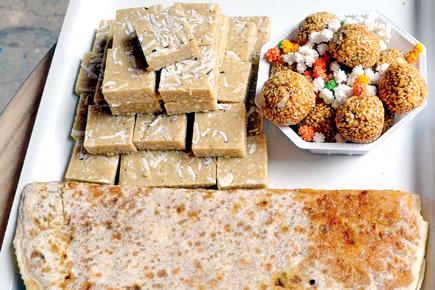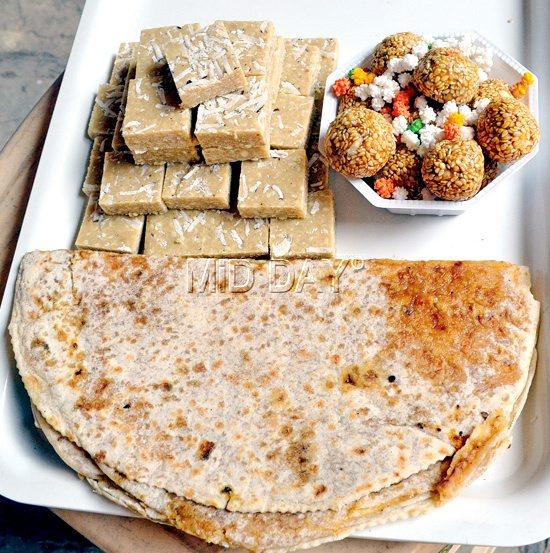With Makar Sankranti around the corner, the guide looks into the culinary traditions associated with it, and eateries that whip up specialties

Til Vadi, Til Laddoo and Gul Poli at Panshikar
The harvest festival of Makar Sankranti celebrates the arrival of spring and the transition of the sun into the zodiac sign of Capricorn. The tradition in Maharashtra that is associated with the festival includes exchanging of dishes that include til (sesame seeds) accompanied by the saying, "Tilgul ghya, goad goad bola" (savour this and speak sweetly), as well as activities such as kite flying.
ADVERTISEMENT

Til Vadi, Til Laddoo and Gul Poli at Panshikar. Pic/ Datta Kumbhar
Food consultant and blogger Saee Koranne-Khandekar from Myjhola.in elaborates on the culinary traditions of Makar Sankranti: "Apart from popular tilgul (sesame) laddoos and vadis, Maharashtrians also make Gulachi Poli (a thin, brittle chapati with a stuffing of the season’s fresh jaggery, roasted gram flour, sesame seed powder, and fragrant spices such as cardamom) which is eaten with fresh ghee, Bhogichi Bhaji, and Bajrichi Bhakri.

Tilachi Satori has a stuffing of jaggery and sesame seeds. Pic/ Datta Kumbhar
Sugared sesame seeds, popped jowar and rice are also popular, especially at Bor Nahaan, a fun ritual wherein infants are showered with Bor (ber), popped rice and jowar, and other sweets. Halvyache Daagine are jewellery pieces made by threading sugared sesame seeds in various colours; these are gifted to newly married women and infants celebrating their first Sankranti."
She adds that dishes are dictated by seasonal and regional produce. "Most festivals came into being to celebrate the harvest of the season. Sesame, the dominant ingredient of choice for Sankranti, is an oil-seed rich in Omega-6 fatty acids, and its consumption is considered healthy in the cold winters. Similarly, sugarcane jaggery is freshly made in the winters, and is used in dishes as well. Bhogichi Bhaji, a stew made of vegetables such as drumsticks, eggplants, pumpkin, carrots and beans is a staple on the eve of Sankranti and celebrates the tender vegetables of winter," she explains.
Her fondest memories of the festival are of her mother making a kadai filled with tilache laddoo, and of her helping roll them out. "We would drop them into a steel dabba, and if they made a loud noise, we knew the laddoos would be well done and hard. Another specialty was the Gulachi Poli. My maternal grandmother makes these with great dexterity and love, and no matter how many she makes, we always seem to run short!" she chuckles.
Khandekar emphasises that while many still make these delicacies at home and add their own tweaks to the recipes, all Maharashtrian stores sell these seasonal goodies in advance.
 Subscribe today by clicking the link and stay updated with the latest news!" Click here!
Subscribe today by clicking the link and stay updated with the latest news!" Click here!






